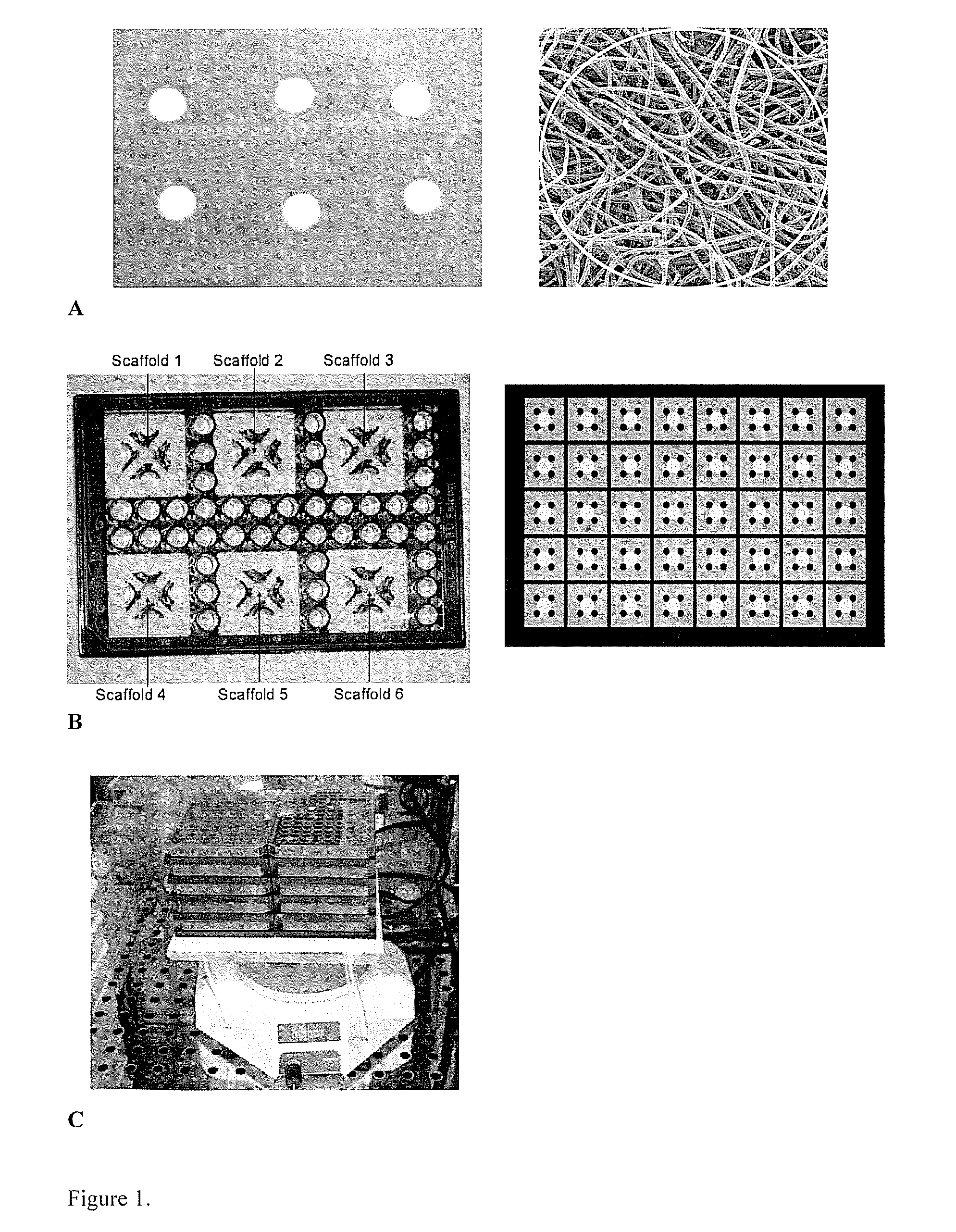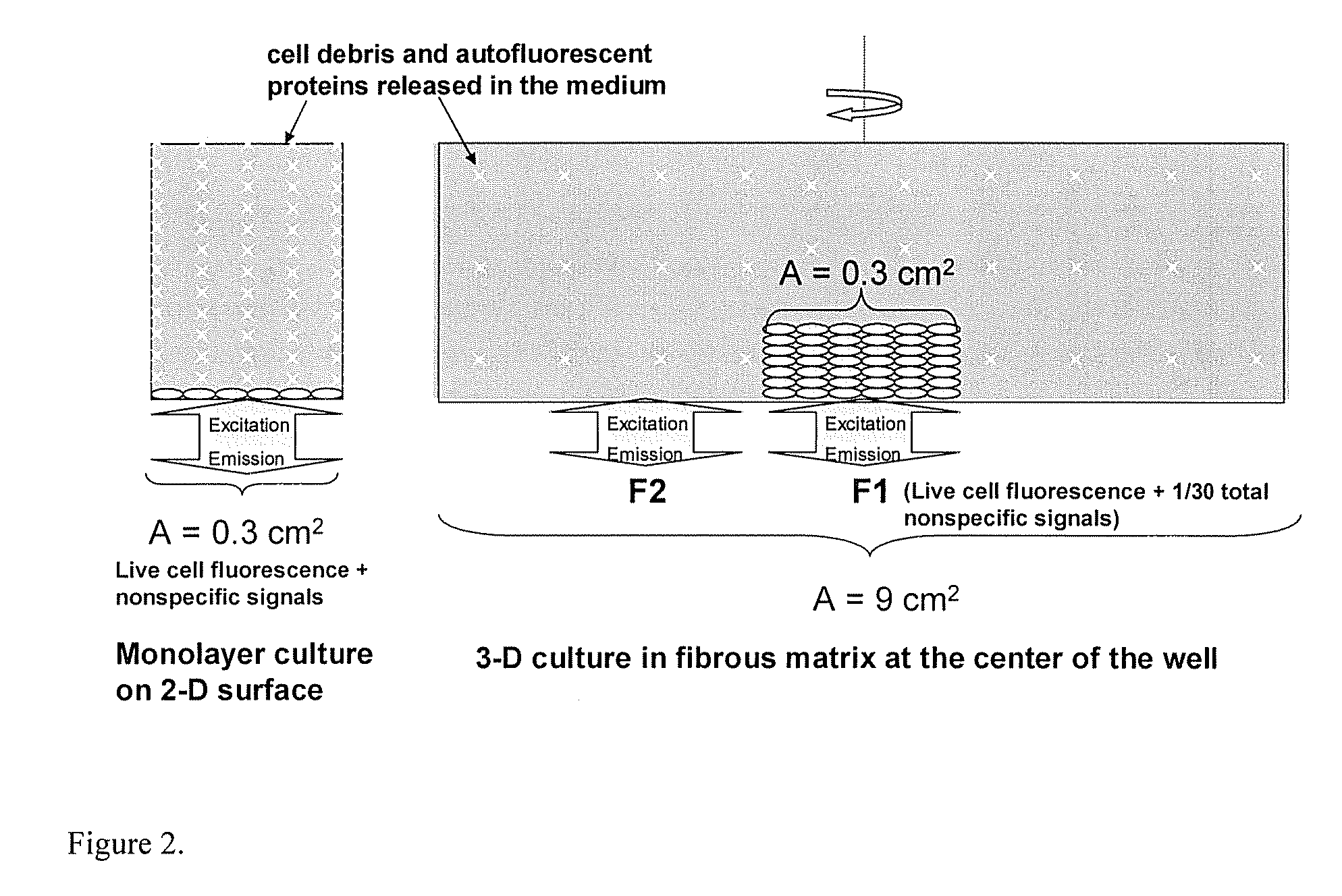Materials and methods for cell-based assays
a cell-based assay and material technology, applied in the field of material and method for cell-based assays, can solve the problems of inherently prone to error, lack of dynamic long-term monitoring, and inability to judge the growth inhibition of cultured cells, and achieve the effect of facilitating three-dimensional cell growth
- Summary
- Abstract
- Description
- Claims
- Application Information
AI Technical Summary
Benefits of technology
Problems solved by technology
Method used
Image
Examples
example 1
Effects of Serum and Fibronectin on Cell Cultures
[0063] Embryonic stem (ES) cells transfected with constitutive CMV promoter, which is cell cycle sensitive, and a gene encoding a light-emitting protein (e.g., EGFP) can be used for studying proliferation and dynamic responses to growth factor or stimuli. Fetal bovine serum (FBS) is an essential ES growth medium component that is required for the ES cell culture, but its optimal concentration has not been well studied. Fluorescent ES cells can be used to study the effect of FBS on ES cell growth and the result can be used to aid the medium design. One day after seeding, the 3-D cell matrices were cultured in ES media with different FBS contents ranging from 0% to 10% (v / v) and the culture fluorescence signals were monitored. As can be seen in FIG. 7, no cell growth was observed when there was no FBS in the medium and cell growth increased with increasing the FBS content from 0% to 3%. However, further increasing the FBS content to 1...
example 2
Acute Cytotoxicity
[0065] For the live-cell kinetic assays, acute cellular events can be easily characterized with online continuous fluorescence measurements without human intervention. The 3-D cell-based assay system was thus applied to test the response of ES-GFP cells to a surfactant, Triton X-100 (Sigma Chemical Company, St. Louis, Mo.). ES-GFP cells in the 3-D system were cultured to reach a high density with 2000 RFU fluorescence intensity. After applying different doses of Triton X-100, the culture plate was immediately put into the plate reader (Cytofluor Series 4000) at 37° C., with the cycle number set at 80 and cycle time at 3 min. The mixing time before each reading was 10 seconds. As can be seen in FIG. 10, the surfactant caused an acute cell death as indicated by the loss in the culture fluorescence. In general, increasing the surfactant concentration in the medium increased cell death, which followed a first order kinetics as indicated by the linear semilogarithmic ...
example 3
Drug Effects on ES Cell Growth
[0066] One application of the fluorescent cell-based assay is for high-throughput drug screening for cytotoxicity effects. Two weak embryotoxic chemicals, dexamethasone (DM) and diphenylhydantoin (DPH), one non-embryotoxic chemical, penicillin G, and one strong embryotoxic chemical, 5-FU were applied at various concentrations to ES cells grown in 2-D and 3-D at the early proliferation stage (drug exposure one day after seeding the matrices).
[0067] The 2-D cytotoxicity assay was performed in 96-well plates by inoculating 5000 cells into each well containing 150 μl of ES medium. The drug was added one day after inoculation. Fluorescent signals were measured twice per day in the culture plates. The fluorescence given by live cells was calculated as the signals obtained after replacing culture medium with the same volume of PBS Iminius the blanks. As expected, the fluorescence time course data showed the drug effects on ES cell growth: decreasing cell gr...
PUM
 Login to View More
Login to View More Abstract
Description
Claims
Application Information
 Login to View More
Login to View More - R&D
- Intellectual Property
- Life Sciences
- Materials
- Tech Scout
- Unparalleled Data Quality
- Higher Quality Content
- 60% Fewer Hallucinations
Browse by: Latest US Patents, China's latest patents, Technical Efficacy Thesaurus, Application Domain, Technology Topic, Popular Technical Reports.
© 2025 PatSnap. All rights reserved.Legal|Privacy policy|Modern Slavery Act Transparency Statement|Sitemap|About US| Contact US: help@patsnap.com



